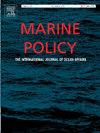快速发展的沿海特大城市水域中海上船只的空间足迹
IF 3.5
2区 社会学
Q2 ENVIRONMENTAL STUDIES
引用次数: 0
摘要
沿海大都市是全球经济的交通门户,但这些发达城市地区周围的海上交通对环境造成了相当大的压力。了解这种压力如何影响海洋物种和生态系统的一个关键起点是绘制海上船只的空间足迹。利用2013 - 2018年六年的船舶跟踪数据,我们绘制了粤港澳大湾区(GBA)内海上交通的精细尺度空间(0.002°)和时间(每日)分布。粤港澳大湾区是全球人口最多(约8600万)的沿海特大城市,也是湾区的第二大经济体。数据显示,平均每天有5981条( ± 1941 SD)独特的血管在大湾区活跃。渔船和非渔船的空间利用在时间上表现出一致、持久和空间密集的覆盖,80% %的船只交通发生在浅水(0-20 m)。大湾区浅水区的移动可能会导致海岸线侵蚀、浑浊、噪音污染和船只碰撞率增加,对许多具有区域重要性的海洋物种构成重大威胁。在大湾区,非渔船的日干扰率是渔船的8倍,在研究期间,一些地区的干扰率超过95% %。我们的研究结果强调了AIS数据如何包含大量信息,这些信息需要相当大的计算能力来提取,因此我们将处理后的数据集公开访问,以帮助未来的海洋保护规划和分析。本文章由计算机程序翻译,如有差异,请以英文原文为准。
Spatial footprint of maritime vessels in the waters of a fast-growing coastal megalopolis
Coastal megalopolises are transportation gateways of the global economy, but marine traffic around these developed urban areas exerts considerable pressure on the environment. A key starting point in understanding how this pressure may impact marine species and ecosystems is to map the spatial footprint of maritime vessels. Using six years of vessel tracking data from 2013–18, we mapped fine-scale spatial (0.002°) and temporal (daily) distribution of marine traffic within the Guangdong–Hong Kong–Macao Greater Bay Area (GBA) — a coastal megalopolis with the largest population (∼86 million) and second-largest economy of bay areas globally. Data indicates that on average, 5981 ( ± 1941 SD) unique vessels were active in the GBA daily. Space-use of both fishing and non-fishing vessels showed temporally consistent, persistent, and spatially-dense coverage, with 80 % of vessel traffic occurring in shallow water (0–20 m). Movement in such shallow water of the GBA likely results in increased rates of shoreline erosion, turbidity, noise pollution, and vessel collisions — posing a substantial threat to many regionally important marine species of conservation concern. Daily rates of disturbance in the GBA by non-fishing vessels were eight times higher than for fishing vessels, with some areas experiencing disturbance across more than 95 % of days in the study period. Our findings highlight how AIS data holds a wealth of information that takes considerable computing power to extract, so we make our processed datasets openly accessible to aid in future marine conservation planning and analyses.
求助全文
通过发布文献求助,成功后即可免费获取论文全文。
去求助
来源期刊

Marine Policy
Multiple-
CiteScore
7.60
自引率
13.20%
发文量
428
期刊介绍:
Marine Policy is the leading journal of ocean policy studies. It offers researchers, analysts and policy makers a unique combination of analyses in the principal social science disciplines relevant to the formulation of marine policy. Major articles are contributed by specialists in marine affairs, including marine economists and marine resource managers, political scientists, marine scientists, international lawyers, geographers and anthropologists. Drawing on their expertise and research, the journal covers: international, regional and national marine policies; institutional arrangements for the management and regulation of marine activities, including fisheries and shipping; conflict resolution; marine pollution and environment; conservation and use of marine resources. Regular features of Marine Policy include research reports, conference reports and reports on current developments to keep readers up-to-date with the latest developments and research in ocean affairs.
 求助内容:
求助内容: 应助结果提醒方式:
应助结果提醒方式:


